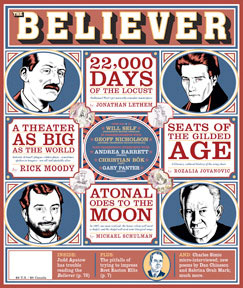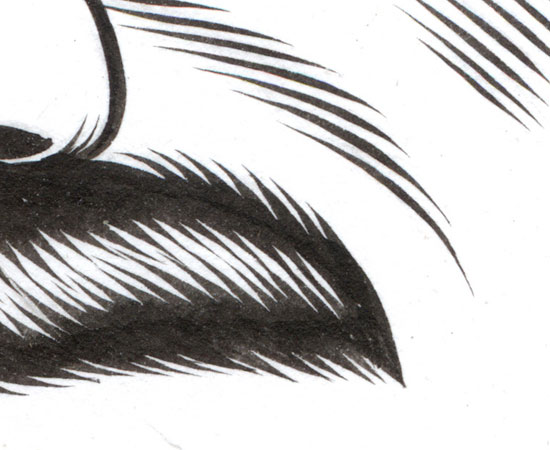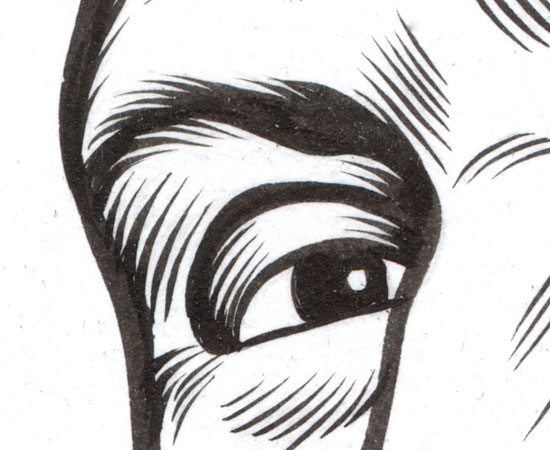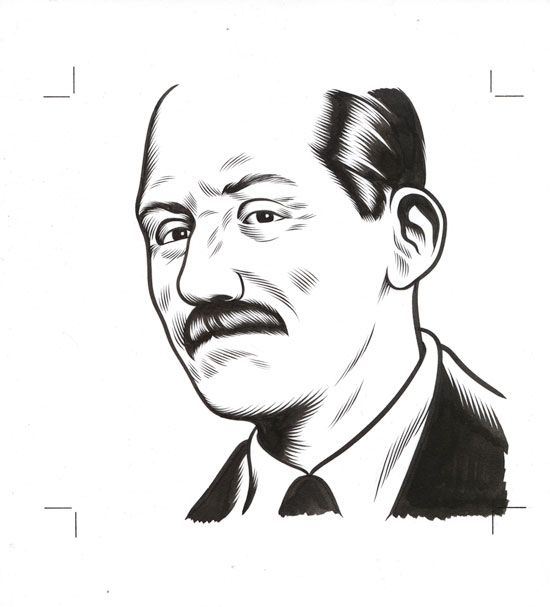(Click for bigger.)
Cartoonist Charles Burns created this portrait of Miss Lonelyhearts and Day of the Locust author Nathanael West for the cover of the June, 2009 issue of McSweeney's The Believer magazine, which featured Jonathan Lethem's wonderful essay on West. Here is how the drawing, flipped and somewhat unhappily spot-colored and squeezed into a circle, was used on the cover:

Burns created hundreds of portraits for the magazine, and these were recently exhibited at the Adam Baumgold Gallery in NYC (see their wonderful webpage for the show here). I've long been a fan of Burns' sharp, clean images and dazzling technique, so I was thrilled to obtain this drawing from the exhibition. It was so hard to choose! Most of my first picks were already taken (I would have loved the Susan Sontag). In the end, it came down to a choice between the Sweet Valley Twins and Nathanael West, and I suppose the issue of "literary merit" tipped the scales in favor of the latter.
It's hard to resist including some close-up details which show off Burns' meticulous "feathering" brush technique:


Beautiful stuff! To some, I suppose, Charles Burns' work looks static, almost machine like, to which my response is, "When did we decide those were bad things?" Of course, this attitude isn't surprising from a collector of Ernie Bushmiller drawings. Furthermore, I don't believe Burns worked directly from a photographic source; the drawing doesn't slavishly follow any photograph of West I've seen, but the resemblance is perfect nevertheless. Charles Burns is just so good that he makes it look easy. You can read my 1995 interview with him here.
Inspired by the drawing, I read Nathanael West's 1939 novel Day of the Locust for the first time in decades, and was thrilled to realize that it truly is one of the Great American Novels™. It's a breezy, fun read, yet dripping with poison, and filled with nothing but hateful characters who all hate themselves as they stumble around numbly, with varying levels of success, through the gimcrackery of the Hollywood landscape. I was surprised to realize that West had written succinctly about this concept I wrote about a couple of years ago. It was also interesting to become aware of the long shadow West's mean-spirited novel cast over pop culture in ensuing decades: David Lynch's Mulholland Drive and Inland Empire, the Coen Brothers' Barton Fink, and Michel Hazanavicius' The Artist all owe substantial debts to Day of the Locust, as do countless other tales of Hollywood treachery and phoniness.
But as scabrous as West's observations are, he also includes passages of haunting surreality, and occasional moments of non-ironic beauty:
It was full spring. The path ran along the bottom of a narrow canyon and wherever weeds could get a purchase in its steep banks they flowered in purple, blue and yellow. Orange poppies bordered the path. Their petals were wrinkled like crepe and their leaves were heavy with talcumlike dust.
They climbed until they reached another canyon. This one was sterile, but its bare ground and jagged rocks were even more brilliantly colored than the flowers of the first. The path was silver, grained with streaks of rose-gray, and the walls of the canyon were turquoise, mauve, chocolate and lavender. The air itself was vibrant pink.
They stopped to watch a humming bird chase a blue jay. The jay flashed by squawking with its tiny enemy on its tail like a ruby bullet. The gaudy birds burst the colored air into a thousand glittering particles like metal confetti.
I have considerably fewer good things to say about John Schlesinger's bloated, tacky film adaptation of Day of the Locust from 1975. It's worth seeing, because it has aged badly in a campy way, contains some ludicrously expensive and complicated sequences, and features some incredible performances. Those incredible performances are, unfortunately, by actors who have been badly, elaborately miscast in their roles, thereby totally ruining the movie. Karen Black is a fun, daffy and dumb blonde who eventually turns mean, but her character in the book is, besides being twenty years younger, a calculating, conniving bitch right from the get-go, stupid yet anything but innocent. Donald Sutherland is similarly impressive yet, conversely, about 20 years too young for his role. The only successful casting in the film consists of Billy Barty as an aggressive dwarf (hardly a stretch), and little Jackie Earle Haley as the creepily androgynous, overtly horrible child actor who becomes the unexpected focus of the film's climax.
Any attempt to turn Day of the Locust into a commercial film is doomed to fail, because the central point-of-view character, Tod, is a jerk who never actually does anything other than think about how much he hates all the other awful characters in the book. He walks around the set; he thinks about working on his painting; he observes a cockfight; he harbors violent rape fantasies towards the "heroine." The plot of the novel is one of steadily escalating pathetic failures with a sickening payoff, hardly the setting for a celebrity-studded big studio extravaganza, and yet that's what Schlesinger tried to do. A for effort, I guess!

6 comments:
Glad to hear the book is holding up since I haven't read it since the 1960s. And the John Schlesinger movie was weirdly wrong: lavishly produced, incredibly boring, and as you point out badly miscast.
Oh, oh, Michael, read it again! It's so good!
I have always been amazed by C B's brushwork.Seeing the original just impresses me more.This is beautiful!
Two of my all-time favorites - Charles Burns and Miss Lonelyhearts - in one post! Thanks! I met Burns in Austin several years ago at the home of a friend, a professor of art at UT. Burns was a very funny guy who generously and happily signed my two FACETASM posters (now the property of Peteykins) and a couple of books and discussed El Borbah with me at some length. And there are several passages from Miss Lonelyhearts that are so excellent I've committed them to memory. The last I checked, West's tour de force was out of print.
Miss Lonelyhearts is a beautiful wild ride. Imdb.com shows a 1958 movie attempt but it's hard to imagine a good outcome.
We decided machine-like drawing was a bad thing when machines (i.e. Photoshop) started doing all the drawing—"democratized it," you might say. Before P'shop, it took fine drafting skill to lay out white highlights in a black background; afterwards, you just paste 'em in.
Post a Comment